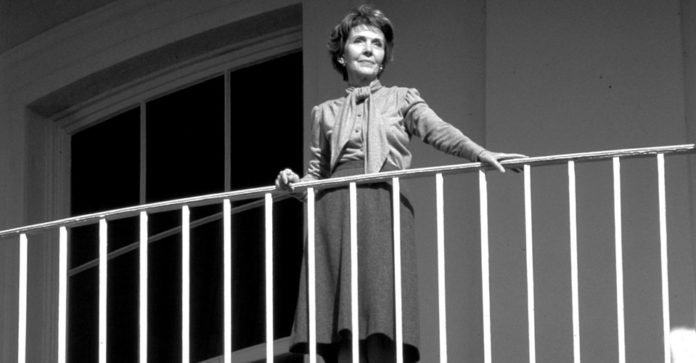
After they all sat down, Glaser poured out the story of the past seven years. Both Reagans had tears in their eyes as she described how Ariel, after months of being unable to walk or talk, had recently opened her eyes and said, “Good morning, Mom. I love you.” Ariel would die seven weeks later, at the age of 7.
That day in the White House, Nancy, with her customary directness, turned the conversation in a direction that Glaser hadn’t anticipated.
“How is it for your husband?” the first lady asked.
“It’s horrible,” Glaser answered. “It has been very difficult for Paul, but he has been remarkable. He is our hero, and he has stood by us.”
Nancy pressed: “What is your relationship with him?”
Glaser suddenly began to understand what Nancy was getting at. She was startled. This, after all, was an administration that didn’t even want to talk about condoms. But she sensed that Nancy was asking out of genuine sympathy. Glaser told her that, yes, she and Paul continued to have a sexual relationship, taking all the precautions her doctors had recommended, and added: “My husband kisses me and touches me, and he is really quite wonderful.”
A meeting that was supposed to have lasted for 20 minutes stretched into an hour. As Glaser and Wick were getting ready to leave, the president’s eyes locked with the distraught mother’s.
“Tell me what you want me to do,” Reagan said.
“I want you to be a leader in the struggle against AIDS, so that my children, and all children, can go to school and continue to live valuable lives; so that no one with AIDS need worry about discrimination,” Glaser replied. “Secondly, you have commissioned a report on the epidemic that’s been written by a phenomenal man. I ask you to pay attention to that report.”
Reagan responded, “I promise you that I will read that report with different eyes than I would have before.”
The Watkins Commission’s report, released on June 27, 1988, was unsparing, starting with its contention that there had been a “distinct lack of leadership” from the federal government. “It was a stunning repudiation of just about every aspect of the Reagan administration’s handling of AIDS, as well as a sweeping battle plan for how the nation might cope with the epidemic in coming years,” Randy Shilts wrote. Among its 579 specific recommendations was a call for the administration to drop its opposition to laws that would prevent discrimination against people who carry HIV; an increase of $3 billion a year in funding for the fight against AIDS at the federal, state, and local levels; comprehensive education about the disease, starting in kindergarten; and a new public-health emergency-response system, giving the surgeon general broad powers.
Read: When an HIV crisis trumps ideology on drug policy
Despite his assurances to Elizabeth Glaser, Reagan took only modest actions in response to the report and ignored its central recommendations. “Time went by, and nothing happened. It was almost unimaginable, but the White House took the report and put it on the shelf. Hope for thousands of Americans and people around the world sat gathering dust in some forgotten corner of some forgotten room,” Glaser wrote later. Glaser had learned on her trip to Washington that her story could move people. But that meant she had to sacrifice her privacy—and that of her two HIV-positive children—to get it out. After Ariel died, Elizabeth and a group of friends started the Pediatric AIDS Foundation, which went to work putting millions of dollars in the hands of researchers more quickly than the government seemed capable of doing. Around that time, she and her husband got word that the National Enquirer was working on a story that would reveal their family’s situation; the couple decided to step forward ahead of it, granting an interview to the Los Angeles Times that was published on Friday, August 25, 1989.








